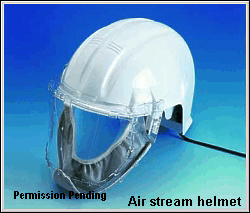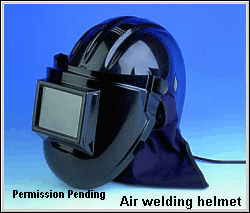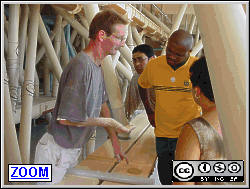 |
| Module 1: Occupational Hygiene - Section 4: Personal Protective Equipment |
| OH4.4: Specific Personal Protective Equipment |
 |
| Module 1: Occupational Hygiene - Section 4: Personal Protective Equipment |
| OH4.4: Specific Personal Protective Equipment |
| The head is normally protected against physical injuries from falling objects.
Hazards associated with the head are impact, falling or flying objects, electric shock,
and scalping. The choice of head protectors is based on the particular hazard to which
the worker is likely to be exposed.
Personal protective equipment used for the head includes hard hats, caps, hairnets. Hard hats worn when working around electricity should have no metal on or in them. Hairnets or caps should be worn whenever scalping accidents may occur. |
 |
Eye and face
 |
Eye protection must protect against glare, corrosive chemicals, flying objects,
foreign objects, radiation dangers or a combination of these. Sunglasses, splash
proof goggles, face shields are examples of personal protective equipment that can
be used to protect the eyes and face.
Eye and face protection tends to be unpopular as it restricts vision. Face shields may make it difficult to protect the respiratory system, for example during welding. |
Ears
All workers who make use of hearing protection devices must be included in a hearing conservation programme.
Lungs
Personal protection for lungs comprises various respirators. Respirators cover the mouth, nose and chin. Respirators protect against toxic substances by removing toxic substances from the air or by supplying air of acceptable quality.
Examples of respirators include masks, air-supplied, air-purified, and self-contained breathing units. Respirators must be selected on the basis of specific type of air contaminant to which workers are exposed. Re-usable respirators must be inspected and cleaned after use and filters replaced when necessary.
Play the video clipThis video clip illustrates an unacceptable practice: the worker (cigarette in mouth) is manually and unergonomically cleaning a tube of flour products. The environment is noisy, and the worker is not wearing a mask or gloves.
Body
Possible hazards to the main part of the body are heat, hot metal splashes, cuts and splashing liquids. Personal protective equipment for the body are overalls and aprons.
Extremities
Hazards to arm and legs are cuts, burns and absorption of chemicals. Personal protective equipment for arms and hands include sleeves, fingercots, and gloves. |
 |
Play the video clipWatch how the worker, who is suffering from dermatitis, puts his hand into the mill to collect a flour sample. He should be wearing gloves!
Injuries to feet and legs are common in heavy industries such as mining, construction, and metal processing. Hazards to the legs and feet stem from falling and rolling objects, and sharp objects. Personal protective for legs and feet include safety shoes, leggings and steel-toe boots.